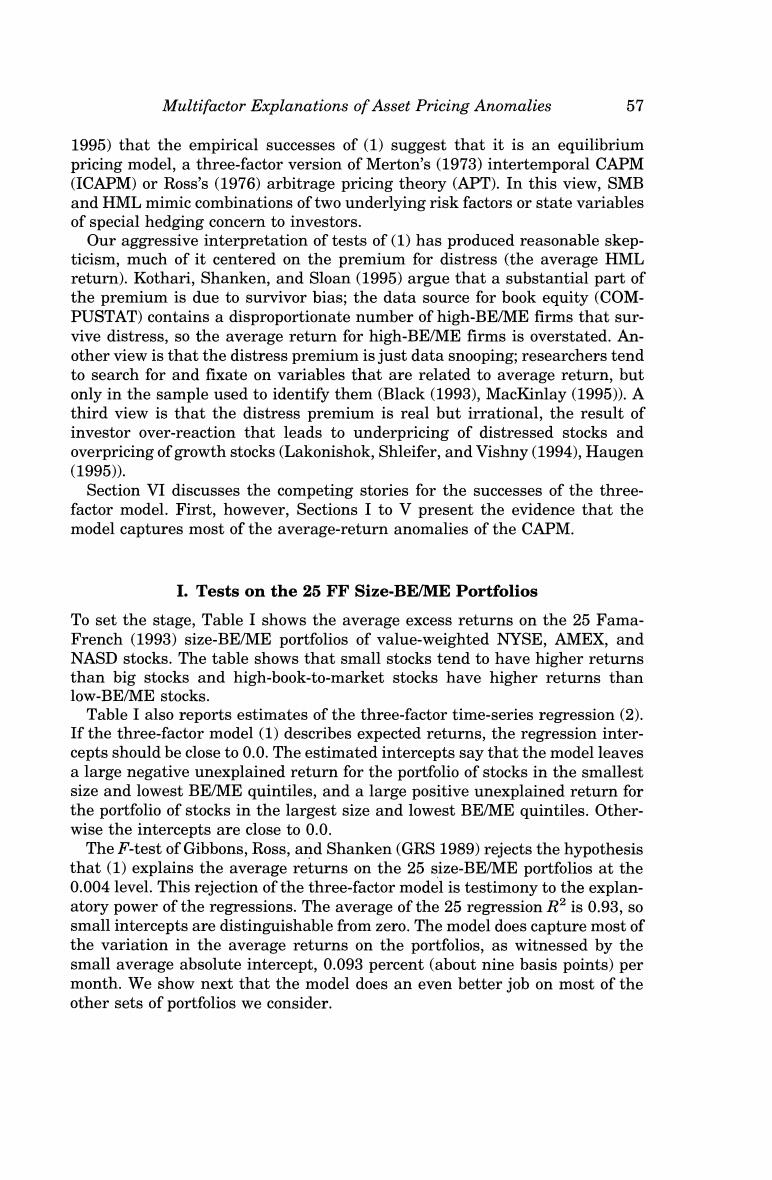正在加载图片...

Multifactor Explanations of Asset Pricing Anomalies 57 1995)that the empirical successes of(1)suggest that it is an equilibrium pricing model,a three-factor version of Merton's(1973)intertemporal CAPM (ICAPM)or Ross's(1976)arbitrage pricing theory (APT).In this view,SMB and HML mimic combinations of two underlying risk factors or state variables of special hedging concern to investors. Our aggressive interpretation of tests of(1)has produced reasonable skep- ticism,much of it centered on the premium for distress (the average HML return).Kothari,Shanken,and Sloan(1995)argue that a substantial part of the premium is due to survivor bias;the data source for book equity (COM- PUSTAT)contains a disproportionate number of high-BE/ME firms that sur- vive distress,so the average return for high-BE/ME firms is overstated.An- other view is that the distress premium is just data snooping;researchers tend to search for and fixate on variables that are related to average return,but only in the sample used to identify them(Black(1993),MacKinlay (1995)).A third view is that the distress premium is real but irrational,the result of investor over-reaction that leads to underpricing of distressed stocks and overpricing of growth stocks(Lakonishok,Shleifer,and Vishny(1994),Haugen (1995). Section VI discusses the competing stories for the successes of the three- factor model.First,however,Sections I to V present the evidence that the model captures most of the average-return anomalies of the CAPM. I.Tests on the 25 FF Size-BE/ME Portfolios To set the stage,Table I shows the average excess returns on the 25 Fama- French (1993)size-BE/ME portfolios of value-weighted NYSE,AMEX,and NASD stocks.The table shows that small stocks tend to have higher returns than big stocks and high-book-to-market stocks have higher returns than low-BE/ME stocks. Table I also reports estimates of the three-factor time-series regression(2). If the three-factor model(1)describes expected returns,the regression inter- cepts should be close to 0.0.The estimated intercepts say that the model leaves a large negative unexplained return for the portfolio of stocks in the smallest size and lowest BE/ME quintiles,and a large positive unexplained return for the portfolio of stocks in the largest size and lowest BE/ME quintiles.Other- wise the intercepts are close to 0.0. The F-test of Gibbons,Ross,and Shanken(GRS 1989)rejects the hypothesis that (1)explains the average returns on the 25 size-BE/ME portfolios at the 0.004 level.This rejection of the three-factor model is testimony to the explan- atory power of the regressions.The average of the 25 regression R2 is 0.93,so small intercepts are distinguishable from zero.The model does capture most of the variation in the average returns on the portfolios,as witnessed by the small average absolute intercept,0.093 percent (about nine basis points)per month.We show next that the model does an even better job on most of the other sets of portfolios we consider